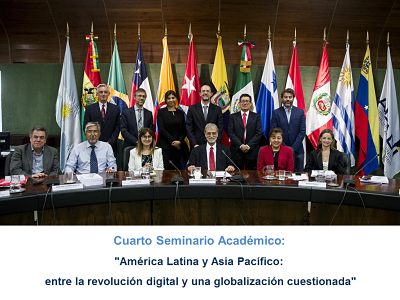A study about the productive integration of Latin America and Asia-Pacific and its challenges.
Work area(s)
Event information

Date
Event type
Practical information
In February 2020, ECLAC’s International Trade and Integration Unit prepared the study “Productive integration of Latin America and Asia-Pacific and its challenges” as a contribution to the Memories of the IV Academic Seminar of the Latin America-Asia-Pacific Observatory, realized in November 2019 in Montevideo. ECLAC’s study presents some results of the project, which investigates value chains with the goal to achieve a more profound integration between Latin America and Asia-Pacific. The project was financed by the Forum for East Asia-Latin America Cooperation (FOCALAE).
The study provides evidence that there exist few regional linkages within Latin America. The mayor linkages exist between Colombia, Ecuador and Peru and countries of the Andean community as well as between Argentina and Brazil and member countries of the Southern Common Market and finally, between Guatemala, Honduras and El Salvador and member countries of the Central American Common Market.
Among the sectors, which are represented in the regional value chains to a larger share, are services, chemicals and petrochemicals, alimentation, beverages and tobacco and motorized vehicles. Concerning the intra-regional inputs, sectors with a major integration in regional value chains are heavy industry, mainly the chemical and petrochemical industry, vehicles and parts, and also plant and equipment. These make up almost 70% of the total intermediate inputs.
The re-exports of imported Asian inputs, which return to Asia incorporated in other products, represent 3% of the exports of Latin America to Asia. In this respect, Mexico is the country, where the share of contents of Asian imports reaches a mayor proportion in the total exports to Asia (7%). In contrast, the proportion of the contents imported from the rest of Latin America in Mexican exports is less than 2%.
The study underlines the scarce intra-industrial relations between the countries of Latin America and Asia-Pacific. The value chains between the regions that stack out correspond to natural resources: agricultural products and mining products exported primarily from South America (iron ore, soy, and copper among others). These are mainly products with a low degree of added value, whose exports are concentrated in only a few countries (Argentina, Brazil, Chile, Mexico and Peru).
From this study it can be concluded, that there is a necessity to advance in the following areas: i) overcoming regulatory obstacles in trade and activating mechanisms that ease harmonization such as technical norms; ii) accumulation of regional origin; iii) the facilitation of trade (interoperability of points of single contact, digital certification, a single authorized operator); and iv) collaboration in programs to support the internationalization of small and medium-sized businesses.
Furthermore, in order to be able to increase the productive integration between both regions, another point of concern is the necessity to overcome regional deficits in infrastructure, solving difficulties in transportation, telecommunication and energy. In the past years, the region has invested less than 2% of its GDP in infrastructure. In this regard, ECLAC has already pointed out that an investment of at least 6% annually is required to close the infrastructural gap. Besides the investment in physical infrastructure, the region should also direct investment towards digitalization of technology, which would allow it to take part in the on-going digital revolution.
Attachment(s)
Organizing institution
Economic Commission for Latin America and the Caribbean (ECLAC)
- https://www.cepal.org
- 56 222100000
Asociación Latinoamericana de Integración (ALADI)
- http://www.aladi.org/
- + 598 24101121
